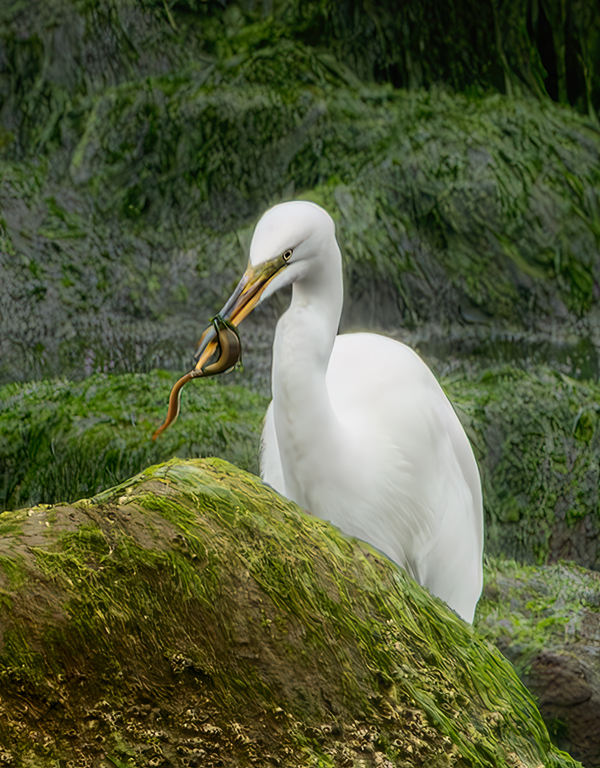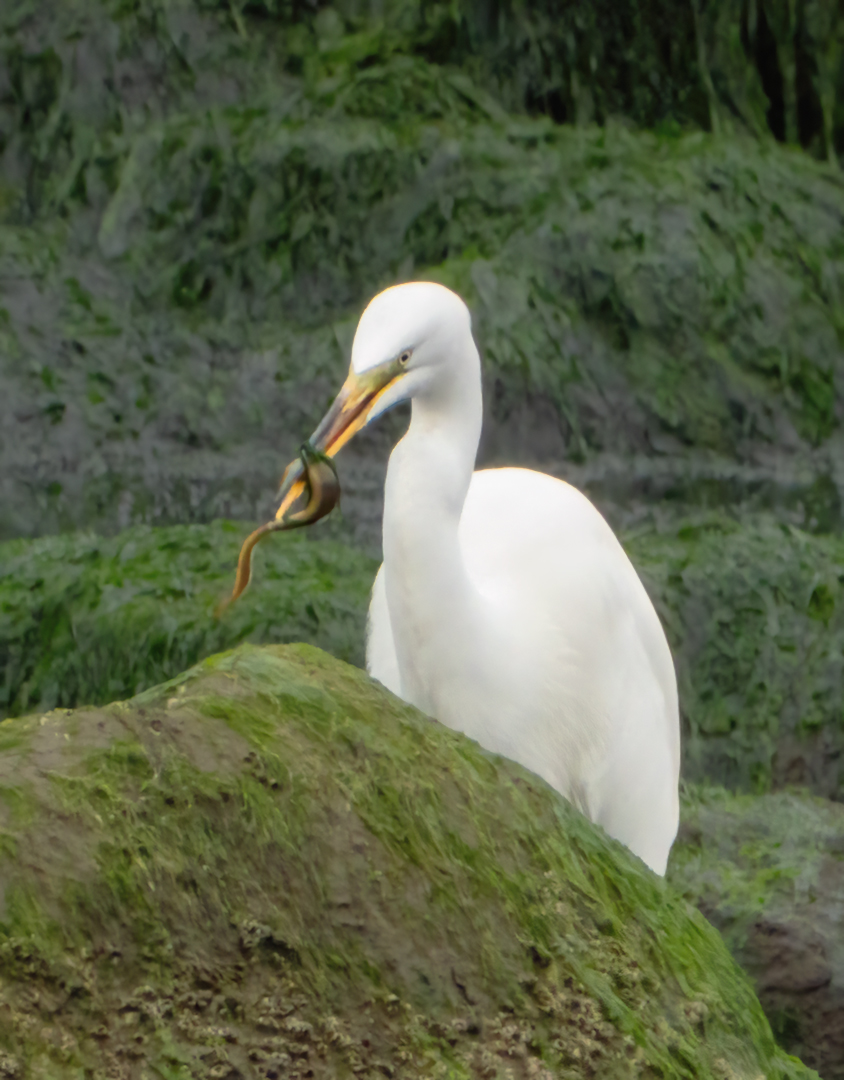Darcy Quimby

June 2025 - Special Treat

Original
About the Image(s)
Camera: Nikon P1000 f8 ISO 800 SS 1/500
This was one morning at low tide in Brookings Oregon. I watched this egret try and eat the eel without success for about 5 minutes. He did however finally succeeded.
In ACR I denoised Lower highlights, shadows, blacks. Upped the whites and contrast. Brought into PS and adjusted the midtones. I did have to upsize with gigipixels.
This round’s discussion is now closed!
10 comments posted
Debbie Porter
Nice capture. Did you up the white on the bird? It seems to have lost it's feather detail? Posted: 06/13/2025 20:33:07
I ended up overexposing the bird and tried the best to recover the feathers. I am hoping the story outweighs the exposure. Posted: 06/17/2025 00:53:41
Great capture. I do think that the whites have been blown out. Bird's edge looks a bit fuzzy as well. Both these could be processing artifacts.
For these white birds, i often under-expose by -1 to -1.5. it helps retain the detail Posted: 06/13/2025 21:56:39
For these white birds, i often under-expose by -1 to -1.5. it helps retain the detail Posted: 06/13/2025 21:56:39
Raj
Thank you for the tip. Looking at it this could be an artifact I did try to sharpen the bird. Posted: 06/17/2025 00:55:49
Thank you for the tip. Looking at it this could be an artifact I did try to sharpen the bird. Posted: 06/17/2025 00:55:49
James Nelson
(Groups 2 & 4)
(Groups 2 & 4)
This bird species is notoorious for being overexposed. If they are being very still, I sometimes bracket the shot and then do a composite in PS. Posted: 06/17/2025 16:05:19
(Group 3)
Darcy, this is a wonderful scene. I feel like you have enough sharpness in the bird and prey (is that a fish?) to carry the image in competition. But you do have some serious processing artifact that I usually associate with Topaz, but may be from Gigapixel in this case. If you have DXO Pure RAW, you might try starting with that then taking it into CR and see if you get a more natural look.
Going back to the film days, I used to use an algorithm of negative compensation depending on the size of the white subject in the frame. Anything from -1/3 to -1 1/3, more if the bird is smaller in the frame. But it's important to remember that white birds often just don't have a lot of detail in their body feathers. I actually like the effect on the bird, it looks ethereal and soft (in a good way). I feel like if you softened up the rock in the FG it might do well in Pictorial, and would work in Monochrome as well. I'm afraid that if you enter it into Nature as is, it might get low scores as judges assume you overprocessed it. But, you never know unless you enter it!
FWIW, I have cropped images much more severely and still had them work well in competition. I think it's your processing order. If you apply your enhancing step (Gigapixel, Pure RAW, even Enhance in LR) first it might work better.
FWIW I have recently started playing around with under-exposing the whites then pulling them up in processing, but bringing up the BG less. It gives is a look that reminds me of medieval paintings where the dark colors have faded but the whites are often still bright. Might be fun if you start bracketing routinely.
Lillian Posted: 06/18/2025 19:42:26
Going back to the film days, I used to use an algorithm of negative compensation depending on the size of the white subject in the frame. Anything from -1/3 to -1 1/3, more if the bird is smaller in the frame. But it's important to remember that white birds often just don't have a lot of detail in their body feathers. I actually like the effect on the bird, it looks ethereal and soft (in a good way). I feel like if you softened up the rock in the FG it might do well in Pictorial, and would work in Monochrome as well. I'm afraid that if you enter it into Nature as is, it might get low scores as judges assume you overprocessed it. But, you never know unless you enter it!
FWIW, I have cropped images much more severely and still had them work well in competition. I think it's your processing order. If you apply your enhancing step (Gigapixel, Pure RAW, even Enhance in LR) first it might work better.
FWIW I have recently started playing around with under-exposing the whites then pulling them up in processing, but bringing up the BG less. It gives is a look that reminds me of medieval paintings where the dark colors have faded but the whites are often still bright. Might be fun if you start bracketing routinely.
Lillian Posted: 06/18/2025 19:42:26
Lillian
I thought about the artifacts after the fact. I will switch the order of things. Thank you. The fish was actually an eel. It took this Egret a good 10 minutes to eat it.
I have never bracketed before when I shoot I will try and venture into that area slowly.
FWIW I need clarifying you leave the BG dark?
Thanks for all your help. Posted: 06/19/2025 12:32:03
I thought about the artifacts after the fact. I will switch the order of things. Thank you. The fish was actually an eel. It took this Egret a good 10 minutes to eat it.
I have never bracketed before when I shoot I will try and venture into that area slowly.
FWIW I need clarifying you leave the BG dark?
Thanks for all your help. Posted: 06/19/2025 12:32:03
Lillian
You got me thinking about some painterly effects. I tried it. Please let me know what you think. Posted: 06/19/2025 13:21:02
You got me thinking about some painterly effects. I tried it. Please let me know what you think. Posted: 06/19/2025 13:21:02

(Group 3)
I like the effect, other than the softness in the face, eye, and eel. If you work on it more, try increasing the contract just in the bird, to make it a little more dramatic.
Lillian Posted: 06/19/2025 15:23:28
Lillian Posted: 06/19/2025 15:23:28
Good Story. Nice Crop. Can't see the feather details, I can live with that because overall the egret is very sharp, especially its eye and beak, where the focus should be. Green algae provide an interesting leading line and a natural setting. The white of the egret strongly contrasts with the vibrant green of the algae and the earthy tones of the rock, making the bird stand out beautifully. The yellow of its eye and beak also adds a nice pop of color. Nice Work.
Given this image, do we always need to see the feathers of the birds? Posted: 06/21/2025 18:19:35
Given this image, do we always need to see the feathers of the birds? Posted: 06/21/2025 18:19:35